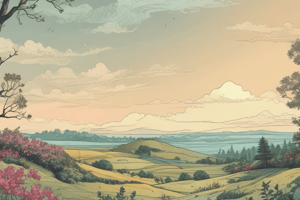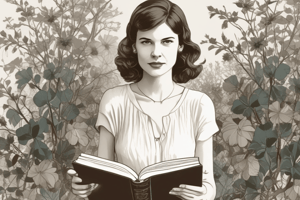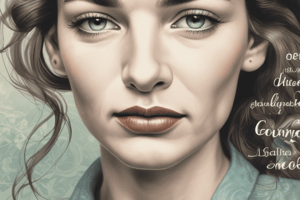Podcast
Questions and Answers
What is a key feature of the poem's structure?
What is a key feature of the poem's structure?
- Unstructured stanzas with no consistent rhyme scheme
- Alternating lines of iambic and trochaic meter
- Structured stanzas, each with a consistent quintet structure (correct)
- A consistent use of couplets throughout the poem
What is the effect of the use of pathetic fallacy in the first stanza?
What is the effect of the use of pathetic fallacy in the first stanza?
- It creates a bleak and downtrodden mood (correct)
- It creates a sense of wonder and excitement
- It highlights the beauty of the natural world
- It adds a sense of humor to the poem
What is the significance of the line 'But let spotted leaves fall as they fall / Without ceremony, or portent'?
What is the significance of the line 'But let spotted leaves fall as they fall / Without ceremony, or portent'?
- It suggests that the speaker is looking for hidden meaning in nature
- It shows the speaker's indifference to the natural world (correct)
- It highlights the importance of ceremony and portent in the speaker's life
- It indicates that the speaker is searching for inspiration in nature
What effect does the use of commas in the third stanza have on the tone of the poem?
What effect does the use of commas in the third stanza have on the tone of the poem?
What is the significance of the line 'I can't honestly complain'?
What is the significance of the line 'I can't honestly complain'?
What was the title of the novel written by Sylvia Plath?
What was the title of the novel written by Sylvia Plath?
At what age was Sylvia Plath first diagnosed with depression?
At what age was Sylvia Plath first diagnosed with depression?
What was the name of Sylvia Plath's husband?
What was the name of Sylvia Plath's husband?
What is a notable aspect of Sylvia Plath's writing style?
What is a notable aspect of Sylvia Plath's writing style?
What is the title of the poem in which Sylvia Plath considers her relationship with the natural world?
What is the title of the poem in which Sylvia Plath considers her relationship with the natural world?
Flashcards are hidden until you start studying
Study Notes
Sylvia Plath's Life
- Born on October 27, 1932, in Boston, Massachusetts
- Father Otto died when she was 8 years old
- Struggled with depression, first diagnosed at age 20
- Attempted suicide in the early 1950s and underwent electroconvulsive therapy
- Graduated from Smith College in 1955 and moved to Cambridge on a Fulbright scholarship
- Married Ted Hughes in 1956, had two children, Frieda and Nicholas, and separated in 1962
- Tragically ended her own life on February 11, 1963
Key Themes in Plath's Work
- Motherhood
- Womanhood
- Identity
- Depression
- Personal struggles
- Control
- Inspiration
- Nature
Plath's Writing Style
- Notable use of figurative language (similes, metaphors, conceits, personification)
- Vivid and shocking imagery
- Juxtaposition of harmonious language with harrowing content
- Innovatively honest tone for her time
- Repetition to highlight feelings
Poem Analysis: "Black Rook in Rainy Weather"
- Considers her relationship with the world and its capacity to inspire
- Themes: need for inspiration, interplay between humanity and nature, divine power, writer's process
- Style: structured stanzas, hidden rhyme, enjambment, caesurae, perceptively chosen imagery, striking aural qualities
Key Quotes and Analysis
- "On the stiff twig up there / Hunches a wet black rook" - creates distinct imagery, bleak and downtrodden mood
- "I do not expect a miracle / Or an accident" - uses first-person narrative to introduce her own thoughts, no expectation of sudden inspiration
- "To set the sight on fire / In my eye" - skillful use of sibilance to encapsulate inspiration
- "Although, I admit, I desire, / Occasionally, some backtalk / From the mute sky" - honest and vulnerable tone, desire for connection with nature
- "A certain minor light may still / Lean incandescent" - hesitant tone, sense of nervousness about connection with nature
Studying That Suits You
Use AI to generate personalized quizzes and flashcards to suit your learning preferences.




